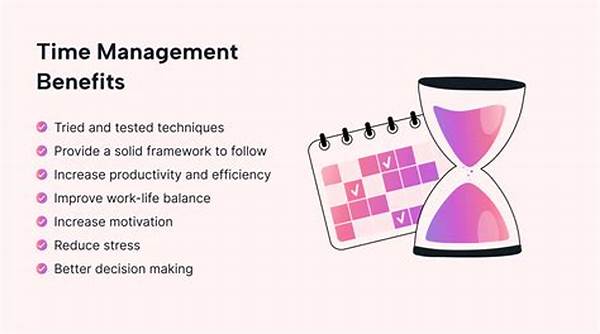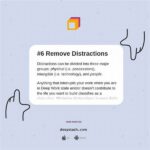Certainly! Creating such comprehensive content requires understanding the nuances of different writing styles and formats. Let’s dive into the topic “The Role of Breaks in Effective Time Management.”
Read More : Why Consistency Is Key To Time Management
—
In today’s fast-paced world, time management has become an essential skill for achieving both personal and professional success. We often find ourselves juggling multiple tasks, staring at endless screens, and trying to meet tight deadlines. Amidst this whirlwind, the concept of taking a break might seem counterproductive. However, breaks, when used effectively, are not the thief of productivity many assume them to be; rather, they are an integral component of efficient time management. So, what exactly is the magic behind these so-called interruptions? How do they transform mundane routines into power-packed hours of productivity? Welcome to the realm where leisure meets labor: the uncharted territory of breaks.
Historically, society has equated more work hours with higher productivity — a belief system that has led to the perennial culture of “no-breaks.” However, recent studies and anecdotal evidence suggest otherwise. In fact, the role of breaks in effective time management has been substantiated by researchers who assert that short, purposeful breaks enhance focus, minimize fatigue, and boost overall efficiency. As countercultural as it may sound, these brief intermissions are where the magic happens.
Consider an anecdote of a high-powered corporate executive, Jane, who once believed that powering through her tasks without a break maximized her output. Over time, Jane noticed her increased stress levels, decreased concentration, and plummeting creativity. A chance encounter with a productivity workshop introduced her to the revolutionary Pomodoro Technique—a time management method dividing work into intervals punctuated by breaks. Embracing this method, Jane found herself more invigorated and observably more productive, without sacrificing her health or sanity.
In this narrative of productivity versus sheer labor, breaks stand tall as unlikely heroes, ready to be enlisted in service of those who dare to break free from monotonous grind. The luxurious concept of a break, often seen as an indulgence, is in truth a strategic ally in time management battles. And so begins your journey into employing this cherished time management strategy, potentially turning skeptics into believers and workspaces into sanctuaries of efficiency.
—
How Breaks Enhance Cognitive Function
Breaks are not just about taking time off. They are essential elements that rejuvenate our minds and enhance cognitive function. The role of breaks in effective time management can be fully realized when they are strategically incorporated into work schedules. Taking short breaks after completing substantial tasks can lead to improved concentration and refreshed ideas, akin to a computer being rebooted to improve performance. The brain, much like any machine, requires regular maintenance to operate at its peak.
Research from various cognitive studies highlights that regular breaks can significantly enhance memory retention and prevent decision fatigue. By understanding when and how to integrate these pauses, individuals can soak in knowledge more effectively, making it a potent tool for students, professionals, and creatives alike. One cannot underestimate the power a well-timed coffee break might have on reigniting the spark of ingenuity.
Imagine a group of innovative thinkers locked in a brainstorming session. As ideas begin to dwindle, a facilitator suggests a 15-minute break. Participants disperse, some engage in casual conversations, others enjoy a quiet moment with their thoughts. Upon reconvening, a flurry of fresh and impactful ideas emerges. This real-life scenario plays out daily in effective teams around the globe, proving that sometimes stepping away is the best way forward.
By understanding the role of breaks in effective time management, one can employ this strategy not just for personal benefit but also as an organizational tool to foster creativity and productivity among teams. Championing breaks is not merely focusing on downtime; it’s recognizing them as periods of intense mental activation disguised as leisure.
—
The Objectives of Integrating Breaks
The integration of breaks within one’s working schedule is not a haphazard act of comfort but a deliberate action geared towards maximizing productivity and well-being. The objectives of incorporating breaks in an effective time management plan include enhancing concentration, boosting creativity, reducing stress and burnout, and improving overall health and well-being. Each objective plays a vital role in creating a balanced and efficient work model.
Firstly, enhancing concentration is achieved when breaks are strategically taken. Our brains are wired to focus intensely for about 90 minutes before they need a brief hiatus to recharge. By embracing this natural rhythm, productivity skyrockets, allowing for sharper focus and more efficient work output. This is the cornerstone of effective time management, ensuring that every moment is utilized to its full potential.
Secondly, boosting creativity: The role of breaks in effective time management shines brightest here. When we give ourselves permission to pause, the subconscious mind works uninterrupted, piecing together thoughts and forming novel ideas. Great inventors, artists, and scientists have famously attributed their breakthroughs to moments of relaxation and leisure, where their minds were free to wander beyond the constraints of focused thought.
Moreover, breaks significantly reduce stress and burnout, acting as a pressure valve for our mental state. By stepping away from intensive tasks, individuals can gain perspective, manage emotions more effectively, and return to their tasks with renewed vigor and a calmer demeanor—directly counteracting the rigidity of prolonged work hours.
Finally, long-term health and well-being cannot be understated. Regular breaks during work mitigate the risks of chronic stress-related ailments. By advocating for breaks as an essential part of time management, individuals are likely to experience a harmonious blend of productivity and a positive work-life balance.
Strategies for Implementing Breaks
The journey to mastering time management through breaks necessitates developing strategies tailored to fit individual needs and organizational culture. Not everyone operates the same way, which means break strategies need a personalized approach. Techniques such as the Pomodoro Technique, employing software tools that automate reminders, or simply listening to one’s internal clock are effective methods to ensure breaks are productive and serve their intended purpose.
Listening to your body’s cues is a powerful, intuitive strategy. If you find your concentration waning or stress levels rising, it could be a sign that a break is warranted. Whether a brief walk, a cup of tea, or a moment of stretching, these activities can recalibrate your mental faculties.
Organizations can foster a break-positive culture by creating spaces conducive to relaxation and providing opportunities for employees to disengage from work periodically. By understanding and harnessing the role of breaks in effective time management, organizations encourage fresh perspectives and foster an environment where stress is minimized, creativity is celebrated, and productivity is maximized.
Lastly, it’s important to review and adjust strategies periodically. Conduct regular assessments to understand what works and what doesn’t, ensuring break methods evolve as personal and professional demands change. With effective planning and a commitment to understanding how breaks influence time management, the path to a more productive life becomes clearer, making room for balanced routines and reaching desired goals.
—
Key Points on The Role of Breaks in Effective Time Management
Designing a Break-Positive Structure
In a world that values efficiency and output, designing a structure that prioritizes breaks requires intentional planning and a shift in mindset. It begins with acknowledging the importance of downtime and embracing breaks as a catalyst for growth rather than a hindrance to productivity. Breaks should be scheduled with the same rigor as any important task or meeting, ensuring they are an integral part of the working day.
A practical approach could involve setting specific time windows for breaks throughout the day. This approach guarantees that individuals step away from their workstations and engage in activities that rejuvenate the mind and body. Organizations can further enhance this by creating inviting break spaces equipped with cozy seating, recreational options, and refreshments, thus making breaks a delightful and anticipated part of the day.
Furthermore, education and awareness campaigns can play a crucial role in this change. Workshops or seminars can highlight the science behind breaks, effectively dispelling myths about productivity and promoting long-term health benefits. By aligning these educational initiatives with company values, a work culture that inherently values breaks is fostered, creating an environment of mutual respect and understanding.
Finally, evaluating the effectiveness of these structural changes is imperative. Gathering feedback, monitoring productivity metrics, and adjusting policies based on real-world data ensures that break strategies remain dynamic and continue to meet the needs of employees and organizations. In this ongoing effort, breaks emerge not as pauses in productivity but as key components of an effective and sustainable time management strategy, pivotal for modern work in a rapidly changing world.
—
The exploration of “The Role of Breaks in Effective Time Management” reveals their multifaceted impact on productivity, creativity, and well-being. Through strategic integration and consistent practice, breaks stand as a testament to the saying, “Sometimes, the most productive thing you can do is relax.” The challenge lies not in understanding the theory but in daring to implement and embrace a break-positive ethos in our daily routines.


